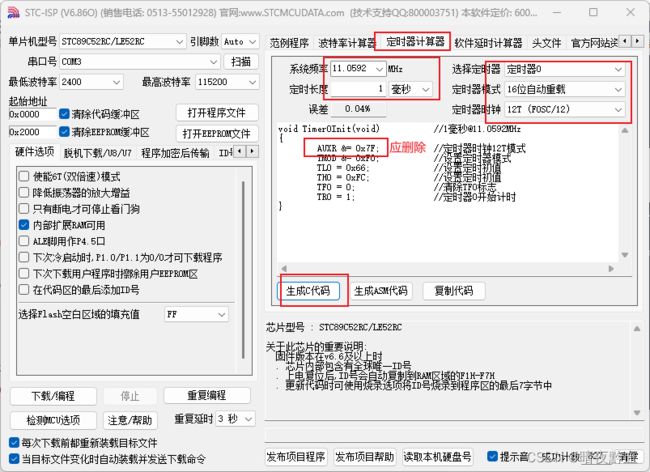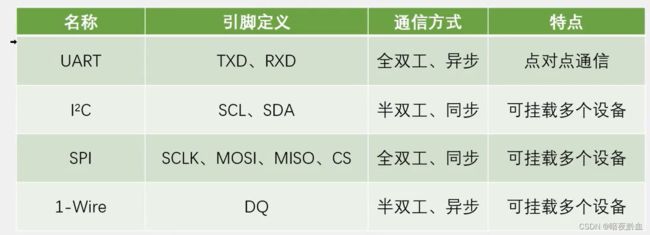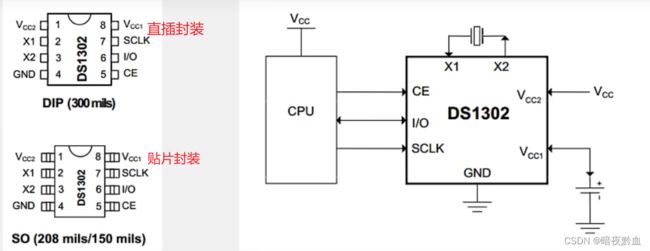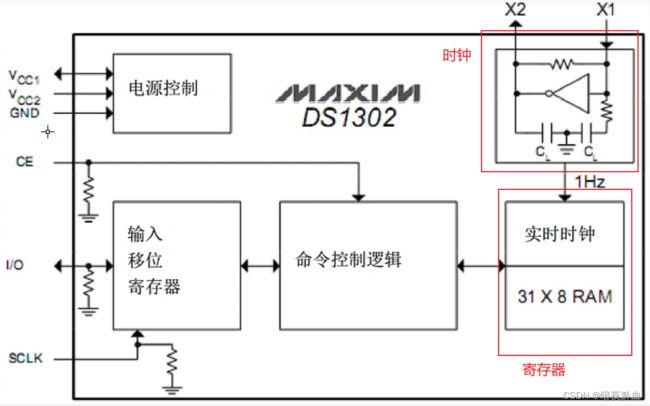51单片机学习笔记
单片机任务二
-
- 模块化编程
- LCD调试工具
- 矩阵键盘
-
- 介绍
- 扫描的概念
- 定时器
-
- 介绍
- STC89C52定时器资源
- 定时器框图
- 定时器的工作模式
- 寄存器
-
- 定时器/计时器0和1的相关寄存器
- 中断寄存器
- 串口通信
-
- 介绍
- 硬件电路
- 电平标准
- 接口及引脚定义
- 常见通信接口比较
- 单片机上的UART
- 串口参数及时序图
- 串口模式图
- 串口相关寄存器
- 数据显示模式
- LED点阵屏
-
- 介绍
- 显示原理
- 原理图
- 74HC595介绍
- 开发板引脚对应关系
- 补充知识点:C51的sfr,sbit
- 控制74HC595(代码)
- 控制点阵屏显示(代码)
- 点阵屏显示动画
- 取字模软件获取动画参数
- DS1302
-
- 介绍
- 引脚定义和应用电路
- 内部结构框图
- 寄存器定义
- 时序定义
- DS1302读写代码
- 补充知识:BCD码
- 显示时钟代码
- 任务二代码(main函数):
模块化编程
把各个模块的代码放在不同的c.文件里,再.h文件里提供外部可调用函数的声明,其他.c文件想使用其中的代码时,只需要#include "XXX.h"文件即可。使用模块化编程可极大的提高代码的可阅读性、可维护性、可移植性等。
个人理解:分开各个模块,使其作用专一,方便更改,或者复制到另一个项目,同时也简洁,更容易读懂代码。
格式:(以Delay函数举例)
- .h文件:可被外部调用的函数、变量的声明
//文件名一般大写
#ifndef _DELAY_H_//if not define如果没有定义,防止重复定义
#define _DELAY_H_
void Delay(unsigned char xms);//外部可调用的函数,注意:这里末尾要加分号
#endif
- .c文件:函数、变量的定义
//写Delay函数的定义
void Delay(unsigned int xms)
{
unsigned char i, j;
while(xms--)
{
i = 2;
j = 239;
do
{
while(--j);
}while(--i);
}
}
写好并添加进工程之后便可在main主函数中,添加头文件#include “Delay.h”(双引号表示自己写的),就可以使用Delay函数了。
注意:
- 任何自定义的变量、函数,在调用前必须有定义或者声明(同一个.c);
- 使用到的自动化函数的.c文件必须添加到工程参与编译;
- 使用到的.h为念必须要放到编译器可寻找的地方(工程文件夹根目录、安装目录、自定义)。
引申知识点
c预编译:c语言的预编译以#开头,作用是在真正的编译开始之前,对代码进行一些处理(预编译)

此外还有#ifndef,#if,#else,#elif,#undef等。
LCD调试工具
- 使用LCD1602液晶屏作为调试窗口、提供类似printf函数的功能,可实时观察单片机内部数据的变换情况,便于调试和演示。
这一节没什么好记的,因为用的都是他写好的函数,只要知道怎么用就好了。用法如下:
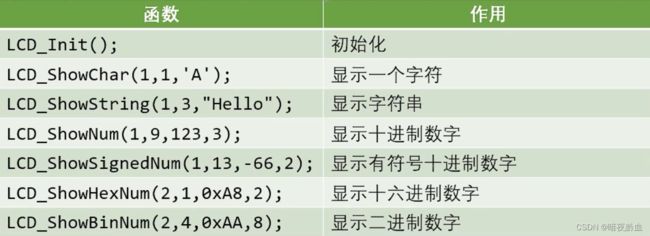
注意:LCD与数码管冲突。
矩阵键盘
介绍
- 在键盘中案件数量较多时,为了减少I/O口的占用,通常将按键排列成矩阵形式
- 采用逐行或逐列的“扫描”,就可以读出任何位置按键的状态(类似于数码管的扫描,只不过一个是输出,一个是输入,后面会谈到)
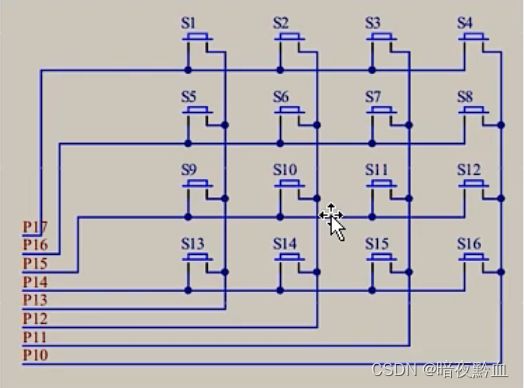
由图可知,P10至P13控制列,P14至P17控制行【可看作四排独立按键理解】
扫描的概念
对比
- 数码管扫描(输出扫描)
原理:显示第1位->显示第2位->显示第3位->…,快速循环,利用人眼视觉残留,实现所有数码管同时显示的效果。 - 矩阵键盘扫描(输入扫描)
原理:读取第1行(列)->读取第2行(列)->读取第3行(列)->…,快速循环这个过程,因为循环速度极快,最终实现所有按键同时检测的效果
以上两种扫描方式的共同特点:节省I/O口的数量
前提:因为矩阵键盘与步进电机(蜂鸣器)引脚冲突,为了避免蜂鸣器响,所以采取逐列扫描
难点:P1P2P3都是弱上拉工作模式,在上面的原理图中如果P1输出低电平,按键另一端连接VCC的话,检测时电流太大。因此另一端连接GND,检测P1口输入是否是低电平来判断按键是否被按下(个人理解)
根据上面的知识内容荣,就可以写出下面的矩阵键盘检测的
.h文件:
#ifndef __MATRIXKEY_H__
#define __MATRIXKEY_H__
unsigned char MatrixKey();
#endif
.c文件:
#include 【上面的写法简单且容易理解】
用LCD液晶屏显示矩阵键盘键码
#include 并且,可以由此写出
矩阵键盘密码锁
#include 定时器
介绍
- 51单片机的定时器属于单片机的内部资源,其电路的连接和运转均在单片机内部完成
- 作用:
(1)用于计时系统,可实现软件计时,或者使程序每隔以固定时间完成一项操作
(2)替代长时间的Delay,提高CPU的运行效率和处理速度
…
STC89C52定时器资源
- 定时器个数:3个(T0,T1,T2),T0和T1与传统的51单片机兼容,T2是此型号单片机增加的资源。
- 注意:定时器的资源和单片机的型号是关联在一起的,不同的型号可能会有不同的定时器个数和操作方式,但一般来说,T0和T1的操作方式是所有51单片机共有的。
定时器框图
定时器的工作模式
模式0:13位定时器/计数器
模式1:16位定时器/计数器
模式2:8位自动重装模式
模式3:两个8位计数器
工作模式1框图:

时钟:
SYSclk:系统时钟,即晶振周期,本开发板上的晶振为11.0592MHz;
T0pin是外部引脚;
12T代表12分频,即12个周期一次输出;
C/T:如果是高电平1,那么就是计数器的功能,如果是低电平0,那就是计数器的功能。
计数单元:
TL0和TH0为一个16位的计数器,有两个字节,高字节为TH,低字节为TL;
当TL0和TH0最大时,就会向中断系统申请中断。
中断系统:
中断系统是为使CPU具有对外界紧急事件的实时处理能力而设置的。
如图所示过程:

当申请中断时,就会跳到中断程序,处理完后在返回主程序;
当加粗样式存在多个中断源时,CPU会根据优先级进行处理,首先响应高优先级的中断请求。
STC89C52中断资源:
- 中断源个数:8个(外部中断0、定时器0中断、外部中断1、定时器1中断、串口中断、定时器2中断、外部中断2、外部中断3)
- 中断优先级个数:4个
- 中断号
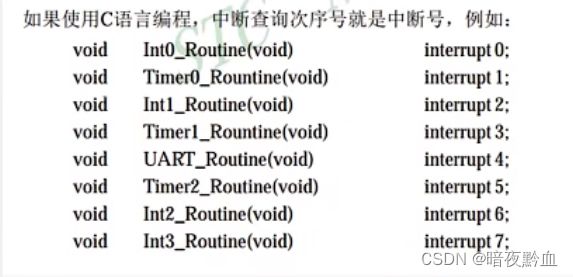
- 注意:中断的资源和单片机的型号是关联在一起的,不同的型号可能会有不同的中断资源,例如中断源个数不同、中断优先级个数不同等等
寄存器
- 寄存器是连接软硬件的媒介
- 在单片机中寄存器就是一段特殊的RAM存储器,一方面,寄存器可以存储和读取数据,另一方面,每一个寄存器背后都连接了一根导线,控制着电路的连接方式
- 寄存器相当于一个复杂机器的“操作按钮”
定时器/计时器0和1的相关寄存器

因此,需要设置TCON(Timer Control)和TMOD寄存器来设置定时器
- TF1: 定时器/计数器T1溢出标志。T1被允许计数以后,从初值开始加1计数。当最高位产生溢出时由硬件置“1”TF1,向CPU请求中断,一直保持到CPU响应中断时,才由硬件清“0” TF1(TF1也可由程序查询清“0” )。
- TR1: 定时器T1的运行控制位。该位由软件置位和清零。当GATE(TMOD.7) =0,TR1=1时就TR1:允许T1开始计数,TR1=0时禁止T1计数。当GATE(TMOD.7) =1,TR1=1且INT1输入高电平时,才允许T1计数。
- TF0: 定时器/计数器TO溢出中断标志。T0被允许计数以后,从初值开始加1计数,当最高位产生溢出时,由硬件置“1”TFO,向CPU请求中断,一直保持CPU响应该中断时,才由硬件清“0”TFO ( TFO也可由程序查询清“0”)。[查询中断便是查询TF0是否为1]
- TR0:定时器T0的运行控制位。该位由软件置位和清零。当GATE(TMOD.3) =0,TR0=1时就允许T0开始计数,TR0=0时禁止T0计数。当GATE(TMOD.3) =1,TR1=0且INTO输入高电平时,才允许T0计数。
- IE1: 外部中断1请求源(INT1/P3.3) 标志。IE1=1,外部中断向CPU请求中断,当CPU响应该中断时由硬件清“0”IE1。
- IT1: 外部中断1触发方式控制位。IT1=0时,外部中断1为低电平触发方式,当INT1 (P3.3)输入低电平时,置位IE1 。采用低电平触发方式时,外部中断源(输入到INT1) 必须保持低电平有效,直到该中断被CPU 响应,同时在该中断服务程序执行完之前,外部中断源必须被清除(P3.3要变高),否则将产生另一次中断。当IT1=1时,则外部中断1(INT1)端口由“1”-“0”下降沿跳变,激活中断请求标志位IE1 ,向主机请求中断处理。
- IE0: 外部中断0请求源 (INTO/P3.2) 标志。IEO=1外部中断0向CPU请求中断,当CPU响应外部中断时,由硬件清“0”IEO(边沿触发方式)。
- IT0: 外部中断0触发方式控制位。ITO=0时,外部中断0为低电平触发方式,当ITO(P3.2)IT0:输入低电平时,置位IEO。采用低电平触发方式时,外部中断源(输入到INTO) 必须保持低电平有效,直到该中断被CPU响应,同时在该中断服务程序执行完之前,外部中断源必须被清除(P3.2要变高),否则将产生另一次中断。当ITO=1时,则外部中断0(INTO)端口由“1”-“0”下降沿跳变,激活中断请求标志位IE1 ,向主机请求中断处理。
【可位寻址:可以对寄存器中的每一位单独赋值】
2.
M1为0,M0为1时,即为16位定时器,我们要用的模式;
C/T:控制定时器还是计数器功能;
GATE:门控端,控制是否由外部控制启动定时器
中断寄存器

结合下图看

由图可以看,启动中断
IE中需要ET0置1,EA置1;
IP为设置中断优先级,可以不考虑,我们暂且置0,低优先级。
定时器的初始化:
#include 一秒定时:
void Timer0_Routine() interrupt 1
{
static unsigned int count = 0;//静态变量
//重置
TL0 = 0x66;
TH0 = 0xFC;
count++;//每次中断加一
if(count >= 1000){
}
}
按键控制LED流水灯方向
#include 定时器计时
#include 串口通信
介绍
- 串口是一种应用广泛的通讯接口,成本低、易使用,通信线路简单可用于实现两个设备之间的互相通信;
- 单片机的串口可以使单片机与单片机,单片机与电脑,单片机与各式各样的模块互相通信,极大地拓展了单片机的应用范围,增强了其硬件实力;
- 51单片机内部自带UART(Universal Asynchronous Receiver Transmitter,通用异步收发器),可实现单片机的串口通信。
硬件电路
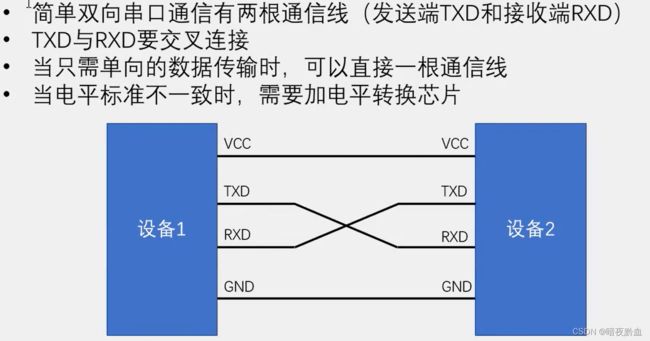
TXD(Transmit Exchange Data)发送,RXD(Receive External Data)接收,因此需要两根通信线。
电平标准
电平标准是数据1和数据0的表达方式,是传输线缆中人为规定的电压与数据的对应关系,串口常用的电平标准有如下三种:
- TTL电平:+5V表示1,0V表示0(单片机)
- RS232电平:-3-15V表示1,+3+15V表示0(多用于电脑,稳定)
- RS485电平:两线压差+2+6V表示1,-2-6V表示0(差分信号)
【TTL电平和 RS232电平传输距离有限,而RS485电平传输距离可以很远,千米级别】
接口及引脚定义
常见通信接口比较
单片机上的UART
-
STC89C52有1个UART
-
STC89C52的UART有四种工作模式:
模式0:同步移位寄存器
模式1:8位UART,波特率可变(常用)
模式2:9位UART,波特率固定
模式3:9位UART,波特率可变

串口参数及时序图
- 波特率:串口通信的速率(发送和接收各数据位的间隔时间)
- 检验位:用于数据验证(减压数据传输是否正确)
- 停止位:用于数据帧间隔
串口模式图
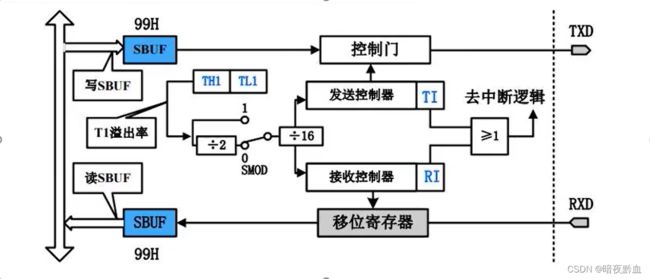
SBUF:串口数据缓存寄存器,物理上是两个独立的寄存器,但占用相同的地址。写操作时,写入的是发送寄存器(SBUF在等号左边),读操作时,读出的是接受寄存器(SBUF在等号右边)。
过程:
发送时,数据通过总线流入,通过定时器控制发送控制器来控制移位寄存器,将数据寄存到发送寄存器,同时触发中断,然后再通过总线发送出去,而速率通过定时器控制。接收类似。
串口相关寄存器

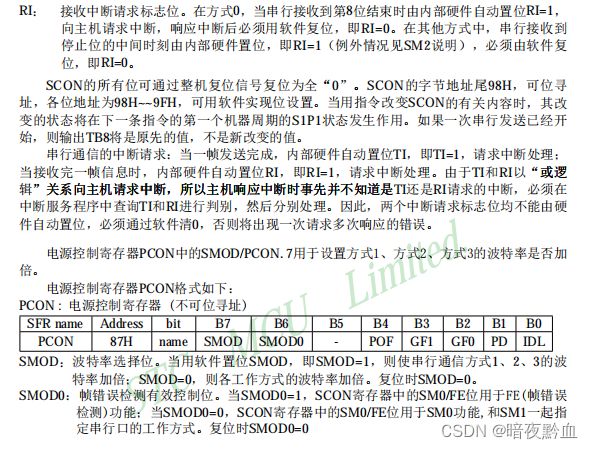
SCON:
我们需要配置模式一:SM0为0,SM1为1;
不需要多机通信,因此SM2配为0;
REN:控制是否允许单片机接收数据,0为不允许;
TB8,RB8为9位数据,不是模式一的,因此不管,置0;
T1,R1标志位初始化给0;
PCON:
SMOD控制波特率是否加倍,不需要,因此给0;
SMOD0用于9位数据帧错误,模式一为8为数据,不需要,置0;
串口初始化
#include 发送一个字节
void UART_SendByte(unsigned char Byte)
{
SBUF = Byte;
while(TI==0);//检测是否完成发送
TI=0;//重置复位
}
数据显示模式
- HEX模式/十六进制模式/二进制模式:以原始数据的形式显示
- 文本模式/字符模式:以原始数据编码后的形式显示(ASCII码)
例子:电脑通过串口控制LED
#include LED点阵屏
介绍
LED点阵屏由若干个独立的LED组成,LED以矩阵的形式排列,以灯珠亮灭来显示文字,图片,视频等。LED点阵屏广泛应用于各种公共场合。
- LED点阵屏分类
按颜色:单色、双色、全彩
按像素:8x8、16*16(大规模的LED点阵屏通常有很多个小点阵屏拼接而成)
显示原理
- LED显示屏的连接方式类似于数码管,只不过是数码管把每一列的像素以“8”字型排列而已;
- LED点阵屏与数码管一样,有共阴和共阳两种接法,不同的接法对应的电路结构不用;
- LED点阵屏需要进行逐行或逐列扫描,才能使LED同时显示

点阵屏上LED的引脚有可能是按最近引脚引出,因此可能是乱序排列
原理图


OE:输出使能,低电平有效【交线帽操作】
SRCLR:串行清零端
74HC595介绍
74HC595是串行输入并行输出的移位寄存器,可用3根线输入串行数据,8根线输出并行数据,多片级联后,可输出16位,24位,32位等,常用于I/O口扩展。

- SER输入串行数据;
- SERCLK:上升沿移位,即在上升沿(从低电平到高电平)时,会将SER的数据移进寄存器;
- RCLK:上升沿锁存,即在上升沿(从低电平到高电平)时,会将寄存器里的数据锁存,并将这并行数据一同输出。
开发板引脚对应关系
补充知识点:C51的sfr,sbit
- sfr(special function register):特殊功能寄存器声明,例:sfr P0 = 0x80;
声明P0口寄存器,物理地址为0x80 - sbit(special bit):特殊位声明
例:sbit P0_1 = 0x81; 或 sbit P0_1 = P0^1;
声明P0寄存器的第1位 - 可位寻址/不可位寻址:在单片机系统中,操作任意寄存器或者某一位的数据时,必须给出其物理地址,又因为一个寄存器里有8位,所以位的数量是寄存器数量的8倍,单片机无法对所有位进行编码,故每8个寄存器中,只有一个是可以位寻址的。对不可位寻址的寄存器,若要只操作其中一位而不影响其他位时,可用“&=”、“|=”、“^=”的方法进行位操作
控制74HC595(代码)
详情请看注释
#include 控制点阵屏显示(代码)
由上面引脚图可知,P0控制列,74HC595控制行。
因此:
#define column P0
/**
*@brief 矩阵屏初始化
*@param 无
*@retval 无
*/
void MatrixLED_Init()
{
SCK = 0;
RCK = 0;
}
/**
*@brief 矩阵屏显示一列数据
*@param x列,y行
*@retval 无
*/
void MatrixLED_Show(unsigned char x, y) //x轴控制列,y轴控制行
{
_74HC595_WriteByte(y); //控制行,高位在上,低位在下,高电平1亮
column = ~(0x80>>x); //控制列,高位在左、低位在右,低电平0亮
Delay(1); //延时
column = 0xFF; //清零,消影
}
然后,我们就可以用上面的MatrixLED_Show函数显示图形了。
点阵屏显示动画
动画即是不断在动的画,因此将画连续显示,就成了动画。我们可以利用上面的点阵屏显示函数,写一个循环语句以达成该目的。
#include 动画数组数据因为运行时是不用改变的,放在RAM占用空间,因此可以加一个code(如代码所示),存到闪存flash
取字模软件获取动画参数
DS1302
介绍
- DS1302是由美国DALLAS公司推出的具有涓细电流充电能力的低耗实时时钟芯片。他可以对年、月、日、周、时、分、秒进行计时,且具有闰年补偿等多种功能;
- RTC(Real Time Clock):实时时钟,是一种集成电路,通常被称为时钟芯片。
定时器时钟由于精度不高,占用CPU,因此通常不选择,而选择实时时钟芯片。
引脚定义和应用电路
32.768kHz晶振精确,可以给出1Hz的稳定脉冲,称作石英钟
这里的CE,IO,SCLK与74HC595里的RCLK,SER,SERCLK是一样的,都是P3_5,P3_4,P3_6。因此实时时钟会与点阵屏冲突。
开发板上的原理图

可以看到,并没有备用电源,因此断电后始终无法继续走。
内部结构框图
寄存器定义
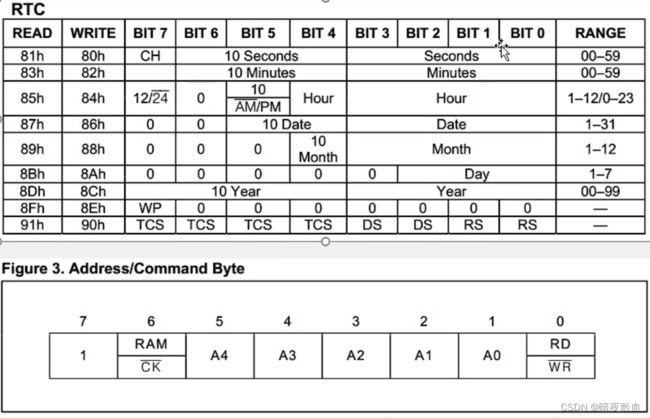
Seconds秒,Minutes分,Hour时,Date日期,Month月份,Day星期,Year年份
第一行的CH置1的话,时钟停止
倒数第二行中有一个WP,控制写保护
Address/Command Byte:命令字
由命令字表可以看到
第6位表示控制RAM还是时钟
第0位表示是否开启写保护(上头有横杠表示低电平有效)
命令字可以在RTC第一二列查到;
时序定义
- CE使能
- R/W为1时读出read,为0时写入write
- 在上升沿写入,在下降沿读出
- 读出数据是由时钟控制的
- 不管是读出还是写入,首先得明确位置,即应先输入命令字
DS1302读写代码

当电压为5V时,上升下降间隔时间最小为50ns,ns级别,单片机因此不用考虑
#include 补充知识:BCD码
- BCD码(Binary Coded Decimal),用4位二进制数来表示1位十进制数
- 例:0001 0011表示13,1000 0101表示85,0001 1010不合法
- 在十六进制中的体现:0x13表示13,0x85表示85,0x1A不合法
- BCD码转十进制:DEC=BCD/16*10+BCD%16;(2位BCD)
- 十进制转BCD码:BCD=DEC/10*16+DEC%10;(2位BCD)
时钟数据是以BCD码存储的
所以在显示时钟时需要将数据转化为十进制
显示时钟代码
因为上面的两个函数读出和写入时需要调用太多,太麻烦
因此,我们写一个DS1302_ReadTime函数直接读出时钟数据,一个DS1302_SetTime函数直接将时间写入时钟
#include 然后主函数
#include 进阶,可调时钟
#include 任务二代码(main函数):
#include 


